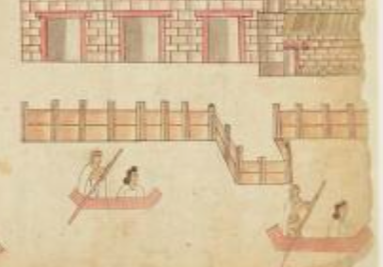acalli (Azca30)
This painted black-line drawing of the unglossed iconographic example of a boat (which we are labeling an acalli) shows what may be a flat-bottomed boat with a rectangular bow and stern. It is likely made of wood. It is painted red or pink. A standing man with long gray hair uses a pole to move the boat through what is presumably the lake. A woman sits in the bottom of the boat, with only her upper body visible (facing the viewer), wearing a huipilli with a large rectangular placard over her chest. Her head is in profile, facing right. She wears the neaxtlahualli hairstyle that is characterized by two protrusions of hair above the forehead and the rest of the hair twisted and resting on her neck.
Stephanie Wood
The contextualizing image shows more than one canoe and an embarcadero. Other canoes, below, have a similar shape. In at least two, the pole has a wide flat blade at the bottom for paddling.
Stephanie Wood
post-1550, possibly from the early seventeenth century.
Jeff Haskett-Wood
canoas, lanchas, mujeres, axtlacuilli
acal(li), canoe or boat, https://nahuatl.wired-humanities.org/content/acalli
la canoa
Stephanie Wood
The Codex Azcatitlan is also known as the Histoire mexicaine, [Manuscrit] Mexicain 59–64. It is housed in the Bibliothèque Nationale de France, and hosted on line by the World Digital Library and the Library of Congress, which is “unaware of any copyright or other restrictions in the World Digital Library Collection.”
https://www.loc.gov/resource/gdcwdl.wdl_15280/?sp=30&st=image
The Library of Congress is “unaware of any copyright or other restrictions in the World Digital Library Collection.” But please cite Bibliothèque Nationale de France and this Visual Lexicon of Aztec Hieroglyphs.

